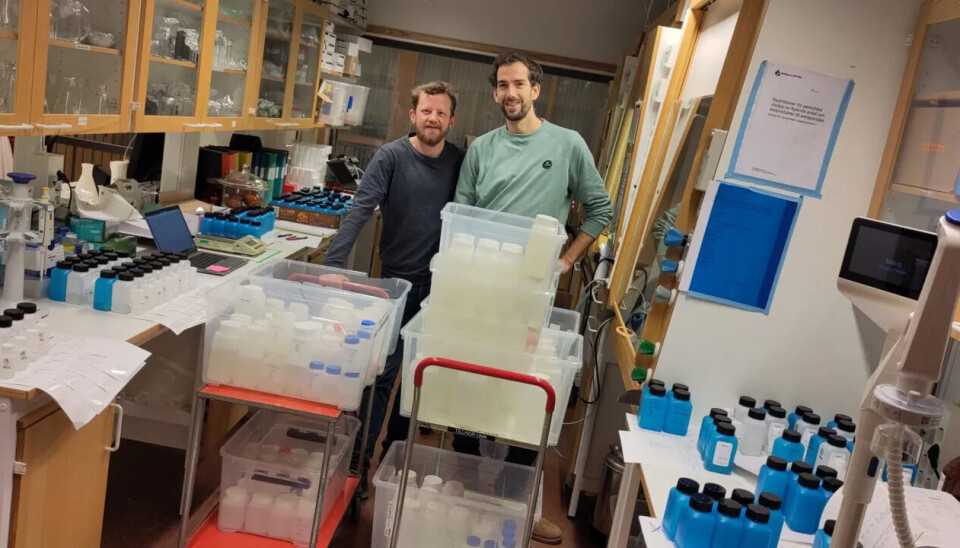THIS CONTENT IS BROUGHT TO YOU BY NGI - the Norwegian Geotechnical Institute - read more
PFAS: This could stop the dangerous chemicals from leaking into the environment
Most of the contamination can be contained in the soil for up to a hundred years, researchers believe.

"PFAS are extremely stable molecules. They spread easily in nature, are toxic, and can cause serious health effects," says Michel Hubert.
He is a senior engineer in NGI's Department of Environmental Geotechnics, and has recently published and defended his doctoral thesis on PFAS at NTNU.

An invisible environmental threat
Since the 1950s, PFAS have been used in everything from firefighting foam and food packaging to rain jackets. They make surfaces water- and grease-repellent, but at a cost: they do not degrade. Instead, they accumulate in nature, and they are now found in blood samples of humans and animals worldwide.
"I often say that global PFAS pollution is just as serious as plastic pollution, which was recently focused in the media due to a possible global plastic treaty. The difference is that we cannot see them. When environmental problems are invisible, they are easy to ignore," says Hubert.
Sutudies show that there are thousands of PFAS-contaminated sites across Europe, many linked to airports and firefighting training facilities.
In Norway, for example, Oslo Airport is one of the areas with high PFAS concentrations in the soil.
For years, the EU has worked to restrict the use of only a couple few of the most hazardous PFAS compounds – out of a family of more than 10,000. Meanwhile, the industry has managed to create many new variants.
"The result is that policy lags behind reality, the regulations cannot keep up with chemical development," says Hubert.
Remarkable use of sewage sludge
In his doctoral research, Hubert explored two methods to reduce the spread of PFAS from contaminated soil: soil stabilisation and soil washing.
The most remarkable discovery was that sustainable biochar made from sewage sludge can bind PFAS in the soil for a very long time – while also giving the sludge a new purpose instead of becoming waste.
“Many studies have shown that biochar works in laboratory experiments. We took the research out into the field and left soil mixed with biochar exposed to rain, wind, and snow for a year. The results were just as good as in the lab,” explains Hubert.
Soil washing was the second method. Hubert found that PFAS binds most strongly to the smallest soil particles – clay, silt, and organic matter.
“By separating out the coarser parts such as sand and gravel, the washing process can become more efficient. Equally important is to clean the wash water afterwards. We tested a special product that removed more than 99 per cent of the most hazardous PFAS compounds,” says Hubert.
From research to practice
Hubert stresses that neither method can "wash the world clean" – PFAS pollution is simply too widespread. Measures must be used strategically at the most contaminated sites, and preferably several measures at the same time.
"It's about hotspots – areas where contamination is so concentrated that it threatens drinking water and ecosystems. Airports, industrial sites, old paper mills. That's where we must act. Otherwise, these chemicals will keep spreading," he says.
At the same time, he points out that cleanup is only the final step.
"Cleaning up PFAS contamination is expensive and demanding. The most important thing is to prevent emissions and reduce use. The EU is now discussing an 'essential use' concept, where PFAS would only be allowed in truly necessary areas, such as medical equipment," says Hubert.
He is now involved in new EU projects and consulting work for industry sites with PFAS problems.
"It's rewarding for me to work with applied research. Using knowledge directly in projects that help address the PFAS problem means a lot. We cannot solve it alone, but we can help prevent the situation from worsening," he says.
Reference:
Hubert, M. Remediation of PFAS-Contaminated Soils and Leachate: An Investigation of Desorption, Removal, and Immobiliziation Processes, Doctoral thesis at NTNU, 2025.

This content is paid for and presented by the Norwegian Geotechnical Institute
This content is created by the Norwegian Geotechnical Institute's communication staff, who use this platform to communicate science and share results from research with the public. The Norwegian Geotechnical Institute is one of more than 80 owners of ScienceNorway.no. Read more here.
More content from NGI:
-
This determines how dangerous a dam failure can be
-
Will it be possible for humans to build and live on the Moon for extended periods of time?
-
NGI-led EU project will digitise the mining industry and ensure increased sustainability
-
Linking art and research to disseminate knowledge on plastic pollution
-
Your teflon frying pan and shampoo release invisible pollution. Huge EU project aims to stop this
-
Establishing a plastics recycling plant in a refugee camp in Ethiopia




































